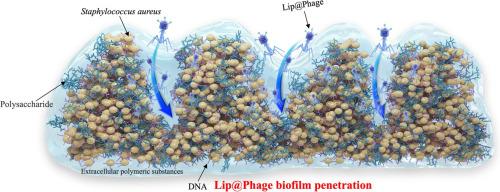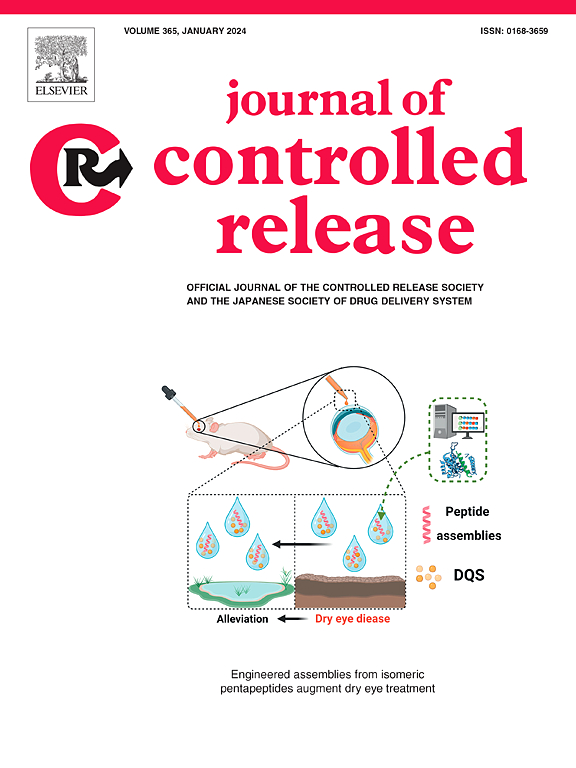用于消除骨科生物膜的噬菌体-脂质体纳米共轭物。
IF 10.5
1区 医学
Q1 CHEMISTRY, MULTIDISCIPLINARY
引用次数: 0
摘要
耐多药(MDR)细菌感染已成为全球公共卫生的最大威胁之一。治疗困难的原因之一是缺乏进入 MDR 细菌生物膜的适当给药策略,因为厚厚的胞外聚合物(EPS)层阻碍了抗生素和纳米粒子的渗透。在此,我们提出了一种新型生物活性纳米脂质体和噬菌体共轭物,用于有针对性地消除骨科感染中的 MDR 生物膜。噬菌体 Sb-1 具有降解 EPS 的能力,它与负载抗生素的脂质体共轭。在遇到生物膜时,噬菌体 Sb-1 会降解 EPS 结构,从而增加细菌对抗生素的敏感性,并使抗生素深入生物膜。因此,本研究通过体外和体内研究证明,使用低剂量抗生素就能有效清除 MDR 细菌生物膜。值得注意的是,在大鼠假体关节感染(PJI)模型中,我们发现脂质体-噬菌体纳米共轭物能有效降低感染区域的细菌负荷,并显著促进骨髓炎的恢复。因此,我们认为噬菌体与脂质体的结合为治疗骨科感染以及其他深部组织感染提供了新的可能性。本文章由计算机程序翻译,如有差异,请以英文原文为准。

Phage-liposome nanoconjugates for orthopedic biofilm eradication
Infection by multidrug-resistant (MDR) bacteria has become one of the biggest threats to public health worldwide. One reason for the difficulty in treatment is the lack of proper delivery strategies into MDR bacterial biofilms, where the thick extracellular polymeric substance (EPS) layer impedes the penetration of antibiotics and nanoparticles. Here, we propose a novel bioactive nanoconjugate of drug-loaded liposomes and bacteriophages for targeted eradication of the MDR biofilms in orthopedic infections. Phage Sb-1, which has the ability to degrade EPS, was conjugated with antibiotic-loaded liposomes. Upon encountering the biofilm, phage Sb-1 degrades the EPS structure, thereby increasing the sensitivity of bacteria to antibiotics and allowing the antibiotics to penetrate deeply into the biofilm. As a result, effective removal of MDR bacterial biofilm was achieved with low dose of antibiotics, which was proved in this study by both in vitro and in vivo investigations. Notably, in the rat prosthetic joint infection (PJI) model, we found that the liposome-phage nanoconjugates could effectively decrease the bacterial load in the infected area and significantly promote osteomyelitis recovery. It is therefore believed that the conjugation of bacteriophage and liposomes could open new possibilities for the treatment of orthopedic infections, possibly other infections in the deep tissues.
求助全文
通过发布文献求助,成功后即可免费获取论文全文。
去求助
来源期刊

Journal of Controlled Release
医学-化学综合
CiteScore
18.50
自引率
5.60%
发文量
700
审稿时长
39 days
期刊介绍:
The Journal of Controlled Release (JCR) proudly serves as the Official Journal of the Controlled Release Society and the Japan Society of Drug Delivery System.
Dedicated to the broad field of delivery science and technology, JCR publishes high-quality research articles covering drug delivery systems and all facets of formulations. This includes the physicochemical and biological properties of drugs, design and characterization of dosage forms, release mechanisms, in vivo testing, and formulation research and development across pharmaceutical, diagnostic, agricultural, environmental, cosmetic, and food industries.
Priority is given to manuscripts that contribute to the fundamental understanding of principles or demonstrate the advantages of novel technologies in terms of safety and efficacy over current clinical standards. JCR strives to be a leading platform for advancements in delivery science and technology.
 求助内容:
求助内容: 应助结果提醒方式:
应助结果提醒方式:


